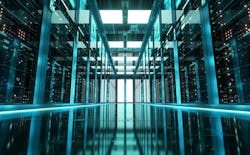In today's digital age, instant and uninterrupted connectivity and a seamless user experience are expected. Every day, we effortlessly binge-watch on-demand TV shows, use apps to order cab rides and chat with friends worldwide without a thought about the immense scale of apps like Netflix, Uber and Meta. To put this in perspective, Netflix has a viewership that’s grown beyond 200 million subscribers, Uber facilitates millions of rides daily and as of September 2023, Meta’s Facebook community expanded to 3.05 billion monthly average users. So, what makes all of this possible? Cloud computing.
Cloud computing is the foundational pillar for these digital giants, offering global resource availability and elasticity. Diving deeper, you will see it is the hyperscale data centers that stand as the true champions of the cloud.
The term ‘hyperscale’ encapsulates the capability of these data centers to automatically adjust and cater to fluctuating demands. Defined by their physical structure, incoming traffic management and software automation, hyperscale data centers are often leased (or, in some cases, owned) and operated by the company it supports. They offer robust, scalable applications and storage services for both individuals and businesses. In sheer size, they span a minimum of 100,000 square feet, and contain upward of 3,000 racks of computer and storage servers, connected with an ultra-high-speed, high fiber count network. Additionally, a typical hyperscale data center contains around 250,000 switch ports within its computing fabric.
However, these data centers are much more than their size; they represent efficiency, adaptability and resiliency. By allocating resources as needed and adapting to user activity, hyperscalers can efficiently manage extensive tasks, such as streaming, social networking and cloud services. They help ensure uninterrupted service and that our online experiences remain smooth and efficient, irrespective of the digital traffic.
Hyperscalers represent the cutting edge of data center innovation and operations. Their size provides them with unique advantages in deploying the latest technologies. With unparallelled purchasing power and close relationships with component suppliers, hyperscalers can customize and optimize solutions to an extent unavailable to other data center operators. Though not all data centers can match the scale and buying leverage of hyperscale players, these giants provide a model of the potential of data center technology fully realized. Their push for continuous improvement serves as a rising tide that lifts the entire industry to new heights of efficiency and capability.
Additionally, hyperscale data centers demonstrate resiliency in their maintenance procedures. Hyperscalers utilize smart management software, which comes in handy when hardware stumbles. However, it’s only during significant malfunctions that the need for crash carts arises, highlighting the robustness of their system. Operations have transitioned from lengthy server repairs to swift, no-hands procedures taking under two minutes. A single technician can even handle an impressive load of 25,000 servers in a given shift.
Hyperscale data centers also have the ability to reduce the overall carbon footprint and support the global sustainability effort. Their extensive size and scale not only allow these facilities to adopt the latest and most advanced technologies, but also enable them to implement advanced cooling, power distribution and energy-saving technologies that smaller data centers might not be able to afford or justify. This efficiency is not just about saving costs; it’s about showcasing environmental responsibility.
Hyperscale computing is a dynamic and transformative force that shapes our digital landscape in ways often taken for granted. It has reshaped business, commerce and society through the delivery and availability of IT services. So, what’s next? Hyperscalers will need to keep their eye on the speed of innovation and growth of deployment of new technologies. The emergence of artificial intelligence, 5G, Internet of Things (IoT), augmented reality and autonomous vehicles will all drive the need for more data and ultra-low-latency communication.
Hyperscale computing is set to continue its meteoric rise, driven by continuing technological advancements and growing data demands. The global expansion of hyperscale data center infrastructure is inevitable, with an emphasis on speed, efficiency and connectivity across regions.
For a more detailed look into hyperscale data centers and how they enable so many households’ digital brands to operate at the scale they do, read part one of our eBook series titled “What is Hyperscale.”
About the Author

Alan Keizer
Dr. Alan Keizer is Senior Technical Advisor for AFL Hyperscale. Alan earned a Ph.D. in Physics from Cornell University and has worked at the intersection of computers and networking for the past four decades. He has been an individual technologist, a business development leader and senior executive. Joining FibreFab in 2006, he was a key contributor to the business which was acquired by AFL Telecommunications in 2013 and became a key component of today’s AFL Hyperscale. Since 2010, his main focus has been development of optical fiber connectivity solutions for hyperscale computing.

Keith Sullivan
Keith Sullivan is Director, Strategic Innovation for AFL Hyperscale. With over 27 years of experience, Keith is an accomplished business leader in the fiber-optics industry with a specialty in data centers. He started his career in 1995 in a factory in England producing specialty fiber assemblies for high-speed devices in the telecom industry. Since then, he has worked for industry-leading organizations in sales, marketing, and product line management.




